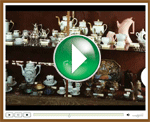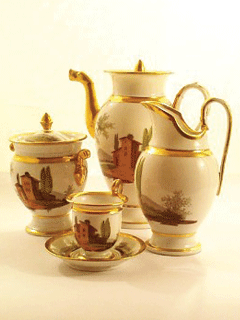
We started our own coffee business approximately 35 years ago.
At home we had a very decorative antique coffee mill and a pewter coffee
pot. Both had belonged to one of our grandmothers.
They were the beginning of our collection and gave us the inspiration and
drive to spend our free time in looking for interesting items which fitted
into our dream: to open a small museum.
We looked for things used by all kinds of people in the past centuries;
things that could tell us a story.
And every time we came home with a new purchase, we had the excited feeling
of having found a treasure!
"Coffee and tea set, 10 parts, porcelain.
Decorated with Italian landscapes and gilded borders. Belgium (Brussels), beginning of 19th century." |
|---|
NOW FOR SALE !
clients and relations an intimate insight into the fascinating history of
coffee over the past four centuries.
Altogether there are about 270 objects, which illustrate:
-roasting the green beans
-grinding the roasted beans
-making the coffee
-serving the coffee
Now let us tell you about some of our treasures.
ROASTING
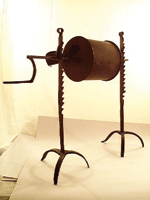 We begin with the oldest object in our collection:
We begin with the oldest object in our collection:
A barrel roaster, which was used over an open fire in the 18th century (Nr.100 of the Inventory: tall 60 cm, diameter barrel 20 cm).In the second half of the 17th century coffee became known in The Netherlands. It was a luxurious novelty at that time. Imagine this roaster in the large fire-place of a well-to-do home. An old woman or a child sitting next to it, turning the handle around so that the beans will be roasted evenly.
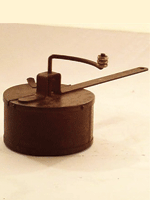
This small pan roaster (Nr.106, tall 15 cm, diameter 13 cm) has a different history. It was made and used in the Second World War (1940-1945).
In the last years of the war coffee became very scarce and people who had hoarded a quantity of green beans were extremely lucky. This roaster fitted on a small makeshift stove in which woodshavings were burnt. (Coal, wood and other
fuel were also hard to get and expensive).
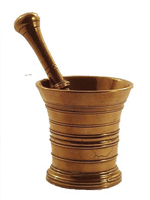 GRINDING
GRINDING
Before making coffee the beans are to be ground.
In the old times a mortar and pestle were used to crush the freshly roasted beans. (Nr. 185, mortar tall 12 cm).
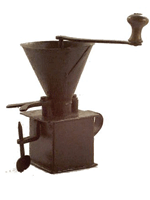
The first coffee mill (sheet iron) was manufactured at the end of the 17th century in Germany.
It looked like the one pictured here. (Nr. 21, tall 19 cm).
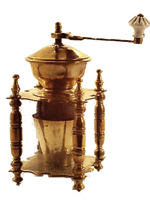
In the following centuries a wide variety in size, material and design came on the market.
Not only simple wooden lap mills and table mills, but also elaborate models made of refined wood or of brass.
Nr. 24 (with glass panels, tall 25 cm) is an example of such an elegant one. Our collection shows the fascinating evolution of the coffee mill.

A special category: the so-called counter mills, used in grocery stores. At first the mills were made of wood with a brass
hopper and long iron handle. In the middle of the 19th century cast-iron mills with two wheels were introduced .
A fine range of these mills is to be found in our collection, as can be seen from Nr.40 (tall 60 cm) of the Inventory.
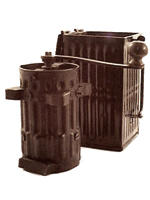
Very interesting is Nr. 122 (tall 24 cm), a portable army mill, used in World War I. It is almost incredible that soldiers carried this heavy equipment around with them: the most important reason would be that coffee could keep up the morale in the trenches.
MAKING COFFEE
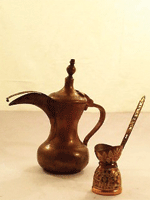
The eldest known method is the Turkish one (also very popular in Greece). Ground coffee and water are boiled together in these pots (Nr. 96, tall 25 cm and Nr. 144 tall 9 cm).
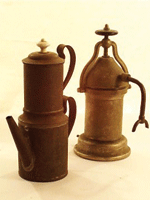
Around the middle of the 19th century the drip method of coffee making was developed.
A plain model (left: Nr. 171, tall 25 cm) could be found in a simple household.

Whereas the same procedure was hidden in the elegant urn (Nr. 51, tall 43 cm) found on the sideboards of English country-houses.
The coffee was kept hot by means of the cylindrical stone which was heated in an oven and then placed in the bottom of the urn.
FINALLY: SERVING A CUP OF COFFEE!
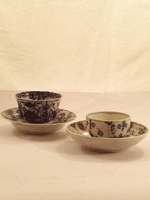
In the 17th century coffee was served (in most European
countries) in earthenware beer mugs. No porcelain cups and saucers were available except in The Netherlands.
The Dutch East India Company imported huge quantities of porcelain cups and saucers when transporting tea from China. These were used in the households and the coffee houses.
At that time the Chinese were the only people who could manufacture porcelain. (Left Nr. 193, tall 6 cm).
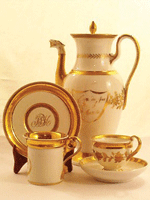 In 1710 the secret of porcelain-making was discovered by a German scientist and from 1718 onwards porcelain tableware was produced in the German city of Meissen.
In 1710 the secret of porcelain-making was discovered by a German scientist and from 1718 onwards porcelain tableware was produced in the German city of Meissen.Porcelain started to conquer the world. For some time it was even more valuable than gold!
Our collection contains beautiful pieces of tableware, for example this white and gold coffee pot (Nr. 127, tall 29 cm), which also served as a "conversation piece" after a delicious dinner.
On both sides a French rebus (picture-puzzle) is depicted.
By the way, we have only been able to solve one of them.
Solving the second one can be a challenge to the next owner
of our collection!
Another magnificent object is the white/gold cup and
saucer (left: Nr. 196, tall 8 cm), dating from about 1800.
On the saucer: a monogram of the Habsburg (Austrian)
Imperial Family and on the cup the words: "Pense a ton
ami" (Think of your friend). Below the handle is the
head of a gilt puto (a small cherub).
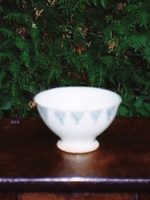
Quite different, but also very attractive is a "boule" (an earthenware bowl) for breakfast coffee, from the French countryside.
It represents a simple way of life, which of course does not keep people from enjoying their coffee. (Nr. 164, tall 9 cm).
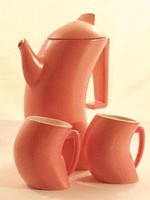
We started with our oldest piece (the barrel roaster) and we want to end with our youngest item:
Nr. 192 (tall resp. 26 and 10 cm), the pink set, which we acquired in 1994.
"Coffee for two", by the Dutch ceramist Daniel Levy.
The shape of this set: original and dynamic, expresses for us two important aspects of good coffee.
Dear Visitors of our website:
We hope you have enjoyed reading this short description
of a few items, selected from our extensive collection.
The Inventory presents a complete summary of all objects,
arranged in the above-mentioned four categories.
Jacob and Marianne
